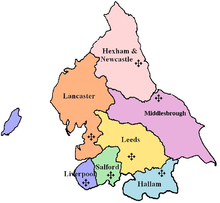- Roman Catholic Diocese of Salford
-
Diocese of Salford
Dioecesis Salfordensis
The coat of arms of the Diocese of SalfordLocation Country England Territory Most of Greater Manchester and neighbouring parts of Lancashire. Ecclesiastical province Liverpool Metropolitan Liverpool Statistics Area 1,600 km2 (620 sq mi) Population
- Total
- Catholics(as of 2004)
2,208,000
287,717 (13.0%)Parishes 184 Information Denomination Roman Catholic Rite Latin Rite Established 29 September 1850 Cathedral Cathedral Church of St. John the Evangelist Secular priests 251 Current leadership Pope Benedict XVI Bishop Terence Brain Metropolitan Archbishop Patrick Altham Kelly Vicars General Anthony Kay Episcopal Vicars Paul Brindle Map 
The Diocese of Salford within the Province of LiverpoolWebsite dioceseofsalford.org.uk The Roman Catholic Diocese of Salford is a Latin Rite Roman Catholic diocese centred around Salford Cathedral in the City of Salford in Greater Manchester, England.
The diocese was founded in 1850 as one of the first post-Reformation Catholic dioceses in Great Britain. Since 1911 it has formed part of the Province of Liverpool. Its current boundaries encompass Manchester and a large part of North West England, between the River Mersey and the River Ribble as well as some parishes north of the Ribble and Todmorden in Calderdale, West Yorkshire. The famous Catholic school Stonyhurst College is also within the diocese. In 2005, the diocese included 207 churches and chapels of ease.
Contents
History
The first post-Reformation Catholic chapel in Blackburn was opened in 1773, and that in Manchester in 1774 (in Rook Street, dedicated to St Chad). In 1843 the Rev. James Sharples, rector of St. Alban's, Blackburn, was consecrated Bishop of Samaria and appointed coadjutor to Bishop Brown, the first Vicar Apostolic for the Lancashire District. He built at Salford St. John's Church, which was opened in 1848 and which subsequently became the cathedral for the diocese.
Dr. Sharples died 16 August 1850, and the first Bishop of Salford in the restored hierarchy was the Most. Rev. William Turner (1790–1872). He was succeeded in 1872 by the Most. Rev. Herbert Vaughan (1832–1903). On his translation to Westminster in 1892, the Most. Rev. John Bilsborrow (1836–1903) was consecrated as the third bishop. The Most. Rev. Louis Charles Casartelli, D.D., M.A., Litt.D., the fourth bishop, was born in 1852, and ordained priest in 1876. He was closely associated with Cardinal Vaughan in the foundation of St. Bede's College, Manchester, in 1876, and was rector of it when he was nominated bishop in 1903. Bishop Casartelli was also a professor at the Catholic University of Leuven, and known as a writer on Oriental subjects.[1]
Bishops of Salford
Main article: Bishop of Salford- 1. William Turner (1851–1872)
- 2. Herbert Vaughan (1872–1892)
- 3. John Bilsborrow (1892–1903)
- 4. Louis Charles Casartelli (1903–1925)
- 5. Thomas Henshaw (1925–1938)
- 6. Henry Vincent Marshall (1939–1955)
- 7. George Andrew Beck, A.A. (1955–1964)
- 8. Thomas Holland (1964–1999)
- 9. Patrick Altham Kelly (1984–1996)
- 10. Terence Brain (1997–Present)
Auxiliary Bishops of Salford
- 1. John Stephen Vaughan 1909-1925
- 2. Geoffrey Burke 1967-1988
Cathedral
Diocesan parishes
Further information: List of parishes in the Diocese of SalfordDiocesan educational establishments
References
 This article incorporates text from a publication now in the public domain: Herbermann, Charles, ed (1913). "Salford". Catholic Encyclopedia. Robert Appleton Company.
This article incorporates text from a publication now in the public domain: Herbermann, Charles, ed (1913). "Salford". Catholic Encyclopedia. Robert Appleton Company.External links
- Official website
- Diocese of Salford, Catholic Hierarchy website
- Giga-Catholic Information
- The Latin Mass Society
Coordinates: 53°29′N 2°16′W / 53.48°N 2.26°W
Roman Catholic dioceses in England and Wales Province of Birmingham Province of Cardiff Province of Liverpool Archdiocese of Liverpool · Diocese of Hallam · Diocese of Hexham and Newcastle · Diocese of Lancaster · Diocese of Leeds · Diocese of Middlesbrough · Diocese of SalfordProvince of Southwark Province of Westminster Others 
This article on a Roman Catholic diocese in the United Kingdom is a stub. You can help Wikipedia by expanding it.
